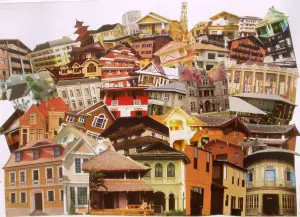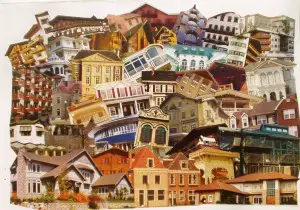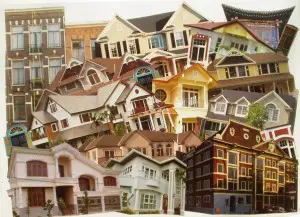Cornelis Hoek is a Dutch artist who has been living in Thailand since 1999. Born on June 25, 1937 in the Netherlands, he is well-known around the world as a concert singer, a weaver, a theatre maker, an impresario, an art collector, and a visual artist. His current exhibition “The World in Our Hands” – Cornelages, A Paper-Cut Collage Exhibition, which is open in Bangkok until June 29, 2010 at Neilson Hays Library, has received good reviews and it’s definitely worth a visit. From his base in Chiang Rai, in the north of Thailand, Cornelis talks about art, the creative process of his cornelages, and life in Thailand.
“Connecting our houses in all possible combinations is a symbol of fraternity, of participation, of sharing life together.”
Voicu Mihnea Simandan: You have been involved in one form of art or another for almost all your life. What is art for Cornelis Hoek?
Cornelis Hoek: To create new things is the greatest joy of human life. Without art, daily life on the earth is grey and empty.
VMS: What’s the symbolism of the many houses in your cornelages?
CH: As a young boy, as far as I can remember, I was always obsessed by the thought of creating houses. I drew them on paper, cut them, folded them, and put them together, building imaginative cities and villages. Maybe I wanted to become an architect. As I became a resident of Thailand, bit by bit, my “old” obsession returned to me. I started cutting houses out of the magazines again, which I later used to create collages on paper of different sizes.
Collecting the photos of houses was rather an amazing work. I used everything and anything: blue, green, and red roofs; modern and ancient architecture; village and city houses; farmhouses and skyscrapers. And all of various size. Cutting them into the right shape was the hardest part, while creating the collages was the most inspiring and pleasant activity. Making cornelages is a way for me to show how we, all people of all nations, belong together, regardless of colour, race, or age. Connecting our houses in all possible combinations is a symbol of fraternity, of participation, of sharing life together.
VMS: The idea of making paper-cut collages is quite simplistic in itself, but you brought it to a different level. Where did the inspiration come from?
CH: The cultural life here in Chiang Rai is quit boring and there aren’t many people I can exchange thoughts and ideas with. So, it felt good to concentrate on the cornelages. About seven years ago I started collecting and cutting photos out of newspapers and magazines. I organized these by subject and then created about 40 books of 26 x 26 cm each. These are books without words, Lieder ohne Worte. But I started working on the cornelages in March 2009. I tried to create imaginary cities from the roofs we all live under. I recommended your readers to watc ‘The Art of Cornelages’ a video of mine about the artistic process involved in making the cornelages.
many people I can exchange thoughts and ideas with. So, it felt good to concentrate on the cornelages. About seven years ago I started collecting and cutting photos out of newspapers and magazines. I organized these by subject and then created about 40 books of 26 x 26 cm each. These are books without words, Lieder ohne Worte. But I started working on the cornelages in March 2009. I tried to create imaginary cities from the roofs we all live under. I recommended your readers to watc ‘The Art of Cornelages’ a video of mine about the artistic process involved in making the cornelages.
VMS: Your exhibition of Cornelages has seen a southward path: Chiang Rai -Chiang Mai – Nan – Bangkok. Where will you take the exhibition next?
CH: The next one will probably be in Pattaya. Abroad, in Europe, later on, but I am in a hurry. My future is not that long anymore and how much longer can I use my fingers to cut papers?
VMS: Tell us about the feedback you’ve had on Cornelages in the places you’ve already exhibited it at.
CH: Last November I wrote a letter to the Queen of the Netherlands to offer my help and support Dutch visual artists abroad. After that, she ordered the Minister of Foreign Affairs to request the Dutch Embassy in Bangkok to sponsor the exhibition at Neilson Hays Library. I am very honoured for their gesture! The positive feedback was immense, but the sales are not what I expected. I also gave two interviews for Channel 3 and Channel 1.
“Without my books and music I could hardly live in Thailand.”
 VMS: You’ve been in Thailand for more than ten years. Has the country welcomed you?
VMS: You’ve been in Thailand for more than ten years. Has the country welcomed you?
CH: I brought my own “culture” with me by containers! Without my books and music I could hardly live in Thailand. Thais never engage in private discussion in response to my art. They also never critique my work, probably from fear of losing face.
VMS: What is your opinion about the art scene in Chiang Rai?
CH: The Chiang Rai art life can sometimes be very surprising in the visual arts field. At art receptions you can meet interesting people, most of whom are art lovers. But, in the performing arts field, the scene is very disappointing. There is no passion in the music or the dance arts. It nearly never touches the heart. I am an excellent voice teacher but can rarely find an ambitious Thai student who wants to learn the art.
VMS: I’ve read that you live in a beautiful house filled with what some say is the greatest private library on art in Thailand and an exquisite European and Asian art collection…
CH: I have always collected books and art. You need to build a nest for yourself in which you live a comfortable life by yourself. Home is where the heart is.
VMS: Tell us about the time you were an impresario for the Great China Show.
CH: The Great China Show that I created was a combination of performances by acrobats, singers, dancers, wushu  fighters, musicians, etc. I toured Europe with them. For eleven years, I had 138 theater companies from China under my supervision. I received two awards from the Shaanxi Cultural Office. I also taught children the musical “The King and I.” I brought the Xing Opera Company to the Muziektheater in Amsterdam. As a sign of appreciation for my efforts, I received many Chinese art objects which are here with me in Chiang Rai.
fighters, musicians, etc. I toured Europe with them. For eleven years, I had 138 theater companies from China under my supervision. I received two awards from the Shaanxi Cultural Office. I also taught children the musical “The King and I.” I brought the Xing Opera Company to the Muziektheater in Amsterdam. As a sign of appreciation for my efforts, I received many Chinese art objects which are here with me in Chiang Rai.
VMS: Still, you chose Thailand as a base for your further artistic endeavors. Why not China?
CH: My Chinese friends asked me to go and live with them in China, but I could not stand the climate there. Some friends suggested that I move to Thailand, where I can live comfortably from my pension. In Europe, that would be impossible.
VMS: What are the artists that most influenced you?
CH: This is a very difficult question to answer, but I’ll try: Callas and Domingo; Bach, Mozart and Mahler; Wittgenstein and Schopenhauer; Vermeer and Francis Bacon; Thomas Mann, Thomas Bernhard, Rilke, Rose Aulander, Glenn Gould, Argerich Martha plus many more.
VMS: Thank you for your time and I’m looking forward to visiting your next exhibition.
CH: You’re welcome.
Voicu Mihnea Simandan
Bangkok, Thailand
June 24, 2010
